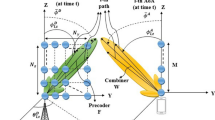Abstract
Three potential vector RAKE (V-RAKE) receiverswith different complexity levels are compared. Thecomparison is conducted by using either single polarizedor dual polarized antenna arrays. An approach where either maximal ratio combining (MRC) orconventional beamforming (BF) is applied at each delay(RAKE finger) is considered. A simpler scheme where onlyone common beam pattern is synthesized for all RAKE fingers is also investigated. In this study itis proven that an array with four dual polarizedelements is very attractive for urban environmentscompared to an array with eight single polarizedelements. It is furthermore found that there is amarginal difference in the overall performance fromusing a V-RAKE receiver with MRC or conventional BF intypical urban environments. However, a loss of up to 2.0 dB is observed for the scheme with one commonbeam pattern for all RAKE fingers.
Similar content being viewed by others
REFERENCES
J. M. Holtzman, L. Jalloul, Rayleigh fading effect reduction with wideband DS/ CDMA signal, IEEE Trans. on Communications, Vol. 42, No. 2/3/ 4, February/March/April 1994, pp. 1012–1016.
S. A. Allpress, M. A. Beach, G. Martin, and C. M. Simmonds, An investigation of RAKE receiver operation in an urban environment for various spreading bandwidth allocations, IEEE Proc. Veh. Tech. (VTC’ 92), Denver, Colorado, May 1992, pp. 506–510.
G. T. Martin and M. Faulkner, 1.9 GHz measurement-based analysis of diversity power versus the number of RAKE receiver tines at various system bandwidths, IEEE Proc. Personal Indoor Mobile Radio Conference (PIMRC’ 97), Helsinki, Finland, September 1997, pp. 1096–1073.
H. Asplund, A. A. Glanzunov, and J. E. Berg, An investigation of measured and simulated wideband channels with applications to 1.25 MHz and 5 MHz CDMA systems, IEEE Proc. Veh. Tech. VTC’ 98, Ottawa, Canada, May 1998, pp. 562–566.
B. Suard, A. F. Naguib, G. Xu, and A. Paulraj, Performance of CDMA mobile communication systems using antenna arrays, IEEE Proc. ICASSP’ 93, Vol. IV, Minneapolis, MN, April 1993, pp. 153–156.
A. F. Naguib, A. Paulraj, and T. Kailath, Capacity improvement with base-station antenna arrays in cellular CDMA, IEEE Trans. on Veh. Tech., Vol. 43, No. 3, August 1994, pp. 691–698.
H. Iwai, T. Shiokawa, and Y. Karasawa, An investigation of spacepath hybrid diversity scheme for base station reception in CDMA mobile radio, IEEE Journal on Selected Areas in Communications, Vol. 12, No. 5, June 1994, pp. 962–969.
K. I. Pedersen, P. E. Mogensen, and B. H. Fleury, A stochastic model of the temporal and azimuthal dispersion seen at the base station in outdoor propagation environments, IEEE Transactions on Vehicular Technology, accepted.
T. B. Sørensen, A.Ø Nielsen, and P. E. Mogensen, Performance of two-branch polarization antenna diversity in an operational GSM network, IEEE Proc. Vehicular Technology Conference (VTC’ 98), Ottawa, Canada, May 1998, pp. 741–746.
UMTS document, UTRA Layer 1 Description; FDD; Transport Channels and Physical Layer, ETSI, August 1998.
K. I. Pedersen, P. E. Mogensen, and B. H. Fleury, Power azimuth spectrum in outdoor environments, IEE Electronics Letters, Vol. 33, No. 18, 28th August 1997, pp. 1583–1584.
U. Martin, A directional radio channel model for densely built-up urban areas, Proc. 2nd EPMCC, Bonn, Germany, October 1997, pp. 237–244.
P. Eggers, Angular dispersive mobile radio environments sensed by highly directive base station antennas, IEEE Proc. personal, Indoor and Mobile Radio Communications (PIMRC’ 95), September 1995, pp. 522–526.
K. I. Pedersen, P. E. Mogensen, and B. H. Fleury, Spatial channel characteristics in outdoor environments and their impact on BS antenna system performance, IEEE Proc. Veh. Tech. (VTC’ 98), Ottawa, Canada, May 1998, pp. 719–724.
H. Iwai and Y. Karasawa, Wideband propagation model for the analysis of the effect of the multipath fading on the near-far problem in CDMA mobile radio systems, IEICE Trans. on Communications, Vol. 76-B, No. 2, 1993, pp. 342–354.
R. Heddergott, U. P. Bernard, and B. H. Fleury, Stochastic radio channel model for advanced indoor mobile communication systems, IEEE Proc. Personal, Indoor and Mobile Radio Communications (PIMRC’ 97), Helsinki, Finland, September 1997, pp. 140–144.
J. H. Winters, Optimum combining in digital mobile radio with cochannel interference, IEEE Trans. on Veh. Techn., Vol. 33, No. 3, August 1984, pp. 144–155.
M. J. Gans, The effect of Gaussian error in maximal ratio combiners, IEEE Trans. on Communication Technology, Vol. 19, No. 4, August 1971, pp. 491–500.
W. C. Y. Lee, Mobile Communications Engineering, McGraw-Hill Publishing Company, New York, 1982.
P. C. F. Eggers, J. Toftgaard, and A. M. Oprea, Antenna systems for base station diversity in urban small and micro cells, IEEE Journal on Selected Areas in Communications, Vol. 11, No. 7, September 1993, pp. 1046–1057.
W. C. Jakes, A comparison of specific space diversity techniques for reduction of fast fading in UHF mobile radio systems, IEEE Trans. on Veh. Tech., Vol. 20, No. 4, November 1971, pp. 81–92.
G. H. Golub and C. F. Van Loan, Matrix Computations, 3rd ed., The Johns Hopskins University Press, 1996.
COST207, Information Technologies and SciencesÐ Digital Land Mobile Radio Communications, Commission of the European Communities, September 1988.
K. I. Pedersen, P. E. Mogensen, and B. Fleury, Dual-polarized model of outdoor propagation environments for adaptive antennas, IEEE Proc. Vehicular Technology Conference (VTC’ 99), May 1999, pp. 990–995.
M. Gudmundson, Correlation model for shadow fading in mobile radio systems, IEE Electronics Letters, Vol. 27, No. 23, November 1991, pp. 2145–2146.
Rights and permissions
About this article
Cite this article
Pedersen, K.I., Mogensen, P.E. Evaluation of Vector-RAKE Receivers Using Different Antenna Array Configurations and Combining Schemes. International Journal of Wireless Information Networks 6, 181–195 (1999). https://doi.org/10.1023/A:1018804021893
Issue Date:
DOI: https://doi.org/10.1023/A:1018804021893




